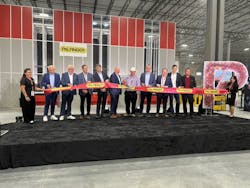PALFINGER opens $15 million new parts distribution center for North America
Key Highlights
- The the new $15 million parts distribution center spans 177,000 square feet and handles 75,000 shipments per year.
- Located centrally in the U.S., the site offers quick access to air and ground freight, facilitating improved logistics for North American customers.
- The AutoStore robotic system holds up to 24,000 containers, enabling rapid, efficient order fulfillment with robots delivering bins every minute.
- The facility will employ 16 workers by the end of 2025, with five operating the AutoStore system, and features real-time data integration across continents, ensuring seamless inventory management and order processing.
On September 17, PALFINGER opened its new parts distribution center for North America in Huntley, IL. The 177,000-square-foot facility will handle 75,000 shipments a year from the manufacturer’s full product range, including knuckle boom cranes, bucket trucks, truck-mounted forklifts, service cranes, hook lifts, cable hoists, and timber and refuse loaders.
Its strategic central U.S. location will help PALFINGER deliver parts and services to its dealers and customers faster and more efficiently, and the $15 million facility will serve U.S., Canada, and Mexico.
During an interview prior to the grand opening ceremony, Ismael Daneluz, vice president of sales & service described the parts and service operation at the new facility as “next level.” PALFINGER put a lot of research into the site decision, and the location in this specific part of the Midwest is close to both O’Hare and Rockford airports as well as major cross-country highways for centralized access.
Facility tour: a centralized Midwest location drives the service business
During a tour of the facility on opening day, PALFINGER consultant Doug Larson, explained the due diligence process. “As we’ve grown rapidly in North America, the ability to deliver parts rapidly to all customers and dealers becomes more difficult, so we made the decision that we needed to centralize a parts distribution center,” Larson said.
“We didn’t start out saying we’re going to be in Huntley. We just started out saying we’re going to be in the center of the U.S. After quite a bit of analysis, which included looking at air freight logistics, ground freight logistics, we ended up in this area,” Larson said.
The location has access to air cargo freight out of Rockford International Airport, which is important, Larson said, for two-day delivery. “We need air freight for a lot of the parts,” he adds. The other big transportation advantage was large interstate access—north, south, east, and west.
Before the official ribbon cutting, Gerhard Stern, global senior vice president of sales and service, said: “This is not just another building. It’s not just another premise for us. This is a commitment. It’s a commitment to our customers. It’s a commitment to provide lifetime excellence to our customers.”
PALFINGER four assembly and manufacturing facilities are spread across the U.S. – in Trenton, New Jersey; Niagara Falls, Ontario, Canada; Oklahoma City, Oklahoma; and Council Bluffs, Omaha. “This very fragmented set up made it sometimes quite a challenge for us to deliver with the speed, with the preciseness, and with the reliability that the U.S. and North American market is expecting,” Sterm said.
The facility construction was started only about four months earlier, Larson said. He learned of the September opening date before he was even done negotiating the deal on the building. It was down to the wire, but Larson thanked the village of Huntley for its work in expediting and helping the process.
Partner company L.I.T., a global logistics company located in Bremen, Germany, also runs a similar automated parts facility for PALFINGER’s European market. “It was October last year that myself and the head of parts from North America visited Bremen, and we said, ‘Yeah, we should build this.’ “
L.I.T. and PALFINGER have worked together successfully before, but the challenging part wasn’t the infrastructure, Larson said. It was the software and all the data pieces that are quite difficult. “We’ve pretty much done it in record time,” Larson said.
The AutoStore, a robotic pick-and-place container system for parts warehousing and distribution
The AutoStore, a massive robotic pick-and-place system for parts fulfillment, will process 75,000 shipments annually at full capacity. The system is very flexible and efficient, even for short notice deliveries on spare parts.
“It holds up to 24,000 containers,” said Rico von Hollen, business development manager at L.I.T. “So that’s huge for this small amount of dimensions.” Each container can be divided into four, automatically transporting up to 96,000 parts. The system is also fully scalable, so PALFINGER can add more containers, and the facility has room for added capacity.
In a typical workday, with five workstations operating, the system can deliver 2,400 bins, with up to five parts per bin. A robot can deliver a bin every minute. “You have high density storage within seconds,” von Hollen said.
Fourteen robots power the AutoStore’s movements, and to preload the entire day’s picking it takes about 15 minutes. “If you were doing that in a traditional fashion, it’d be about four hours,” Lawson said. The robots can also be charged on regular outlets, and the system consumes much less energy than a typical fully automated shelf system.
Operators simply log into the system in the morning, and the day’s orders are ready to go. Five operator stations run the entire system. Including five AutoStore operators, the facility will employ 16 workers total by the end of 2025. L.I.T. also has operational offices at the Huntley facility.
The data that runs the AutoStore travels a long way in milliseconds, back and forth from Germany to the U.S. “The AutoStore is driven fully on L.I.T. servers, which are located in Germany,” von Hollen said. “So all the data is transferring back and forth to Germany to the U.S. and Austria, because the SAP from PALFINGER is located in Austria. That’s a real-time connection on two continents."
“One of the really interesting things about the whole system is how all the data flows, where a dealer enters an order sitting somewhere in Georgia, and it hits the server in Austria and goes to Germany and comes back here, tells the forklift driver to go pick up something out a pallet rack, or it tells the machine to get something out of the AutoStore, and it does it all in milliseconds,” Lawson said. All the invoices flow from that system, including a phone app that shows where every part is everywhere in North America, and how many parts are in stock and where they are located.
Setup for the AutoStore took about three weeks, including quite a bit of testing time. The final product was up and running during the grand opening, filling its first orders the two days before the event. Within the next four months, the AutoStore will get filled with about 60,000 unique part numbers. “If you were to take the same amount of these parts and put them in a traditional racking space, one, it would take a lot more space. But the bigger issue is it’s way less efficient. Here, the operators stand, and the parts are coming to them, instead of you going to the parts,” Lawson said.
The AutoStore containers are 60 x 30 x 40 cm (23.6 x 11 x 15.7 inches) and hold up to 66 pounds, and they stack onto each other. “We can stack them 18 high,” von Hollen said. “That’s the reason why they are so efficient.”
About the Author

Anna Townshend
managing editor
Anna Townshend has been a journalist and editor for almost 20 years. She joined Control Design and Plant Services as managing editor in June 2020. Previously, for more than 10 years, she was the editor of Marina Dock Age and International Dredging Review. In addition to writing and editing thousands of articles in her career, she has been an active speaker on industry panels and presentations, as well as host for the Tool Belt and Control Intelligence podcasts. Email her at [email protected].
